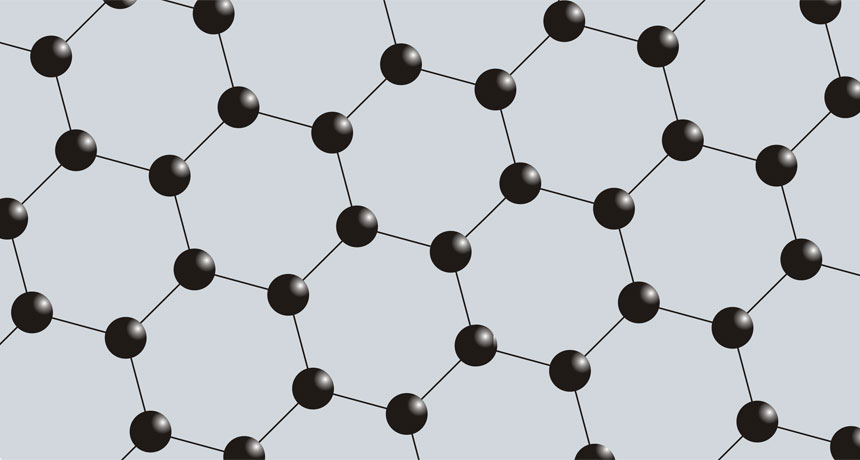Graphene’s allure becomes magnetic
Thin carbon sheets can borrow valuable property from nearby compound

MAGNETIC CARBON Researchers magnetized a sheet of graphene without disturbing its well-structured array of carbon atoms (illustrated above).
Mpfiz/Wikimedia Commons
Although atom-thick sheets of carbon called graphene have many extraordinary properties, magnetism isn’t one of them. But a new study reveals that graphene can simply borrow the magnetic properties of a nearby material.
The technique, reported in the Jan. 9 Physical Review Letters, creates a magnetic form of graphene by precisely placing it above a magnetic, insulating compound. It’s the first time researchers have magnetized graphene while also preserving the ultrathin material’s other tantalizing properties, particularly the super speed of electrons coursing through it.
Graphene, which was discovered in 2004, is mostly valued for its promise in electronics. Its electrons move much faster than those in semiconductors such as silicon. But graphene does not exhibit magnetism, which would be useful for certain technological applications.
Scientists have proposed inducing magnetism in graphene by peppering sheets of it with iron or other magnetic materials. But those impurities would mess up the pristine carbon structure that enables the electron superhighways, says Yafis Barlas, a theoretical physicist at the University of California, Riverside.
Barlas and his Riverside colleagues wondered whether a magnetic material placed close to graphene would share its magnetism while leaving the carbon sheet’s structure and electronic properties intact. They chose the magnetic compound yttrium iron garnet, an electric insulator that wouldn’t interfere with the graphene’s electron flow. To maximize contact between materials, the researchers laid the graphene atop an extremely smooth sample of the yttrium iron garnet. Even tiny nooks and crannies would have prevented the atom-thick graphene sheet from lying flat.
The researchers confirmed that the graphene was magnetized by exposing it to an external magnetic field. In nonmagnetic conducting materials, electrical resistance in the direction perpendicular to the current rises steadily as the sample is exposed to an increasingly strong field. But the resistance in the graphene jumped disproportionately to the strength of the field. This phenomenon, known as the anomalous Hall effect, indicated that the graphene was ferromagnetic, the type of magnetism exhibited by iron and yttrium iron garnet. “The graphene just borrows the magnetic properties,” says Allan MacDonald, a theoretical condensed matter physicist at the University of Texas at Austin who was not involved in the research.
The finding should further boost interest in the use of graphene in future computers, Barlas says. A magnetic form of graphene could offer researchers a platform for developing small, energy-efficient computer chips that encode data in the spins of electrons.
MacDonald also points out that graphene is not the only promising ultrathin material. He wonders whether the same technique could magnetize a sheet of molybdenum disulfide, a material whose electronic properties resemble those of silicon. “It’s definitely an interesting line of research for two-dimensional materials,” he says.







